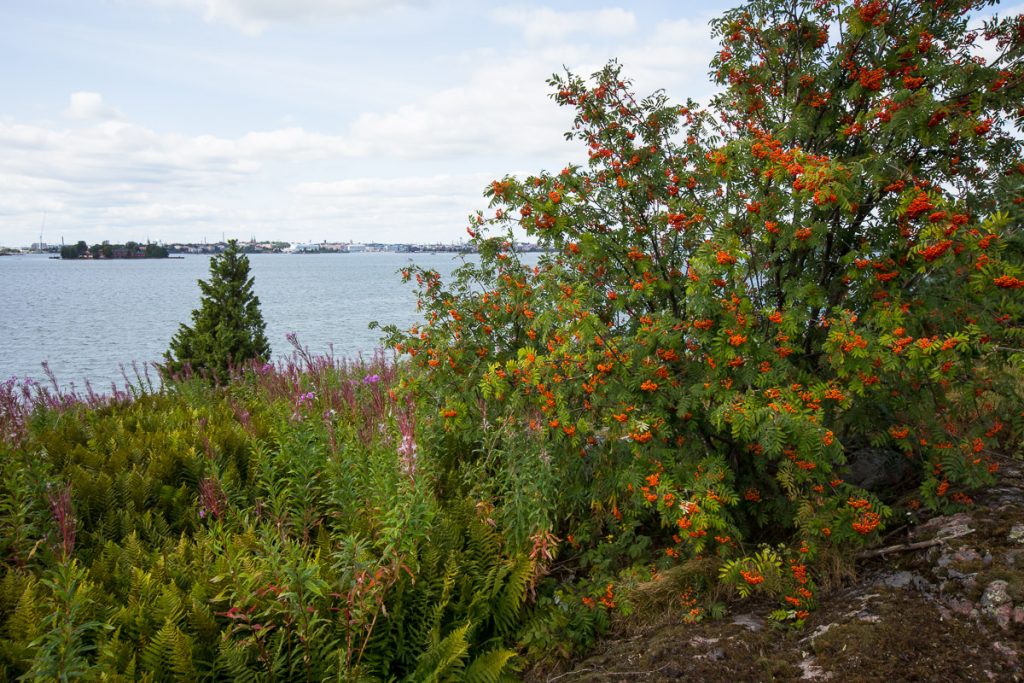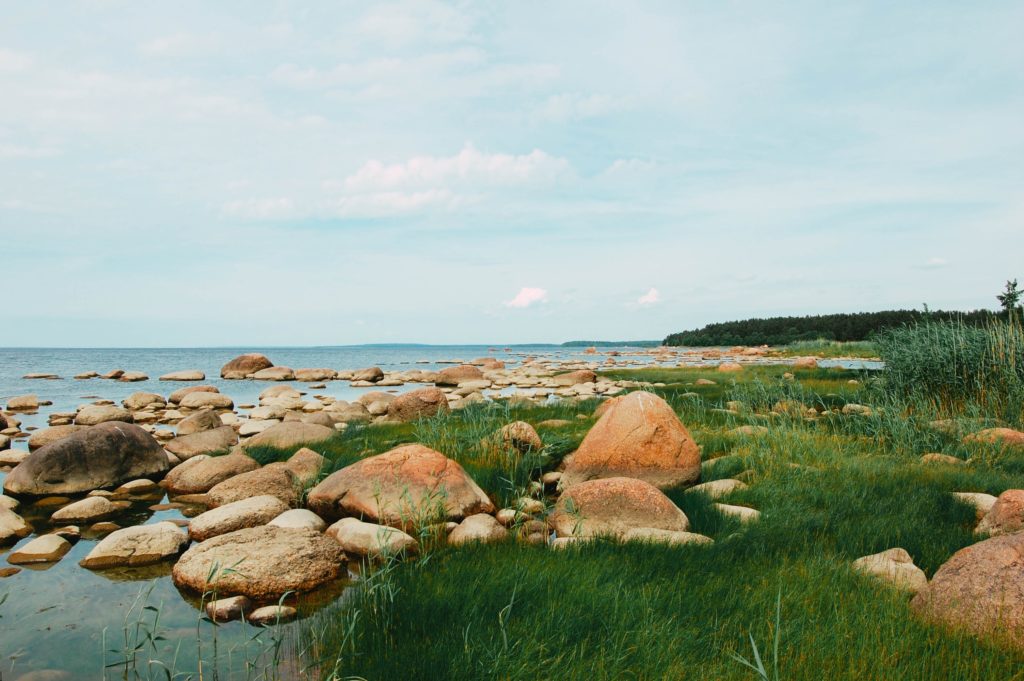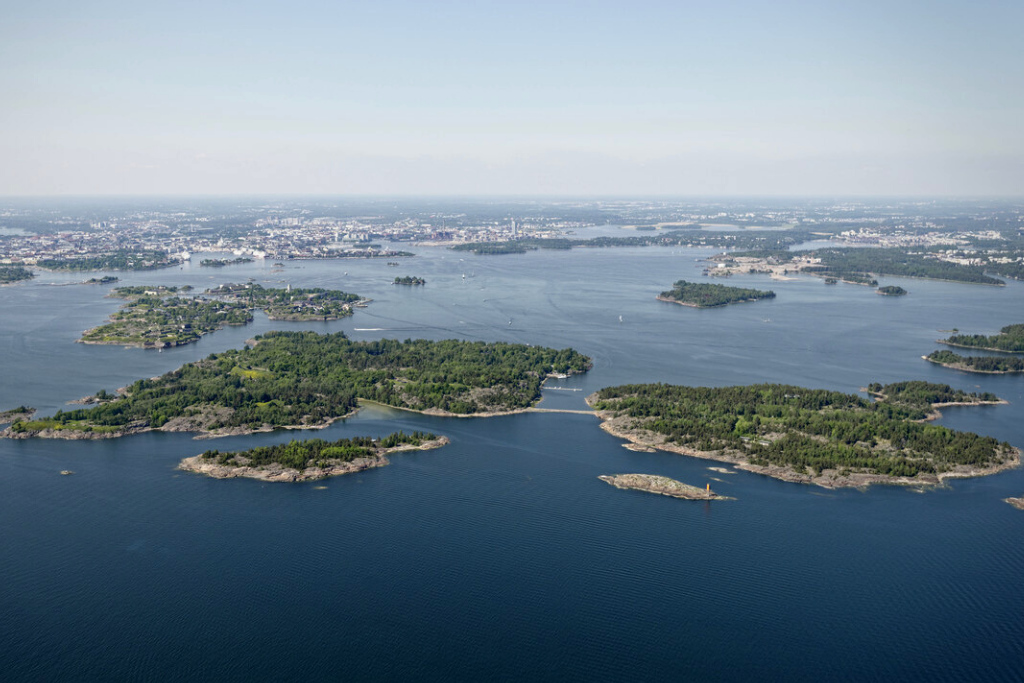The Helsinki archipelago features 300 islands and 130 kilometres of shoreline. Securing the fragile archipelago nature is vitally important. Helsinki is committed to protecting its valuable nature. Efforts to protect the marine nature will take the input of all of us as city residents. The Helsinki archipelago is an important part of our city, and we must all bear our responsibility for it.
In its strategy, Helsinki has laid down substantial goals to protect marine nature. The ecological quality of green and blue areas, their accessibility and their health effects will be secured. The risks related to the wear, erosion and disturbance of nature and cultural heritage sites, the changing of landscapes, waste accumulation and increasing water turbidity must be identified in advance. We are also actively working on solutions for these issues.
Stop for a moment and let the archipelago enchant you
Observing nature is a good way to slow down and detach yourself from the hectic pace of daily life. Every one of us can observe nature and its plants and animals without any guidebooks. For example, you can simply fix your eyes on a bird cutting across the sky or a small critter darting along the rocky shore. In the archipelago, you can have many amazing experiences simply by exploring and observing your surroundings.
Archipelago nature
The City of Helsinki manages a wealth of spectacular archipelago areas and seaside parks right by the city and its nearby areas. These areas are accessible to all either free of charge or for a rental fee. In terms of water transport to and from the islands intended for outdoor recreation, transport and tours provided by private companies are available. The archipelago can be explored in many ways, such as by renting a boat or kayak. It is also easy to discover maritime Helsinki by land. Helsinki’s coastline commands amazing views of the archipelago nature. Helsinki protects its marine nature, and the archipelago boasts 28 conservation areas, which provide a safe habitat for endangered species.

The sea and the archipelago form an incomparable environment around Helsinki. The archipelago nature is unique in the impact it can have on us. The rich and rugged environments, the hardness of the winter and the subtlety of the spring provide profound experiences. The Helsinki area includes about 300 islands.
In Helsinki, 28 islets or groups of islets have been protected under the Nature Conservation Act. Most of them were established to protect nesting birds, but some also feature valuable plant life. In addition to these areas, the City of Helsinki’s nature conservation programme for 2015–2024 features ten islets that are not yet protected. The City cannot decide on their protection alone because they are owned by the state or jointly by multiple private parties, with the City as one of them. Once these locations are protected, if not before, the situation of the birds nesting in the Helsinki archipelago will be good or even excellent. That said, simply protecting the islets does not guarantee that the birds can nest in peace. Many small predators are also a factor – particularly the mink and raccoon dog as well as predatory birds, such as the white-tailed eagle, which has become substantially more prevalent. Moreover, a protection decision does not automatically eliminate the disturbances caused by people navigating the sea areas.
The open islands of the outer archipelago with their small forests are important feeding and resting sites for many birds during migration. Even islands that are not regarded as actual ‘bird islands’ may have some birds, such as the common eider, nesting at their highest points.
Islets, small islands and treeless tips of larger islands that feature large nesting colonies of archipelago birds are regarded as bird islands. Bird populations are the largest and most diverse on treeless islets with subtly varying terrain including small meadow patches, rocky spots, patches of wetland, depressions filled with junipers and seaside meadows that together form a multicoloured mosaic. On the other hand, small islands that feature shrubbery and forests are important for the greylag goose and common eider, for example. Thanks to the fertilisation provided by the birds, unique and rich vegetation usually springs up on bird islands.
The Helsinki archipelago is unique and diverse.
Its nature is fragile and vulnerable.
Archipelago birds make themselves seen and heard
Bird watching is easy in the Helsinki archipelago as the area features more than 100 bird species. Seagulls, cormorants, common eiders, terns, razorbills and black guillemots nest on small bird islets. Swans, goosanders, geese, common sandpipers and common shelducks nest in the more peaceful parts of the archipelago, whereas parasitic jaeger survey their surroundings from tall cliffs. The sheltered valleys of the more verdant islands are home to the spotted nutcracker and barred warble. The endangered Caspian tern and the southern dunlin also live in the Helsinki archipelago.

Anyone who has been to the archipelago has both seen and heard the highly prevalent seagulls, In the archipelago, the birds are the most visible, audible and well-known element of the fauna. Still, the archipelago also features quiet and unseen species that require us to take action to maintain their habitats. Considerate boaters try not to disturb the tranquil nature of the archipelago by maintaining a sufficient distance from the rocky islets and rushes.
(Photo: Esa Nikunen)
Of the birds that can be found in Finland, the Anseriformes, Laridae, Terninae, Alcidae and Charadrii, which traditionally nest on the coast, are regarded as archipelago birds. In the archipelago, you can also spot predatory birds, such as the white-tailed eagle and osprey. The outer archipelago is a nesting area for birds such as the common eider, Eurasian wigeon, tufted duck and various species of gull. While the Arctic tern also nests in the outer areas, the common tern prefers the inner archipelago. The rocky islets feature large populations of white wagtails and northern wheatears. In the same areas, you are also sure to see oystercatchers.
During the migration season, you can often see millions of birds flying over the Helsinki archipelago. The long-tailed duck, common scoter and brant are among the largest migratory families. The shallows of the archipelago also feature resting spots for migrating birds.
Please respect the environment and observe the restrictions and prohibitions set to protect it. Let the birds nest in peace

In the spring, access and landing is restricted to ensure safe for the birds and other animals. Particularly within conservation areas, landing is prohibited on many islands, islets and shores. The prohibitions are often indicated with a red or yellow warning sign.
Some access restrictions may be in effect year-round. Even if you do not intend to land, keep your distance from the animals and their nests. If a bird leaves its nest as your boat approaches, you are already too close. Keep your pets on a lead to protect the nature and nesting birds in particular.
Everyman’s rights
The Finnish everyman’s rights (public access rights) provide all residents of Helsinki with the opportunity to explore and spend time in the archipelago. However, it is always important to consider the environmental effects of your presence and ensure that you do not disturb the forests or other natural areas. They are a national treasure and the most important element in building our relationship with nature.
The everyman’s rights do not apply to conservation areas. The Nature Conservation Act provides the opportunity to restrict access and fishing, and to protect plant life to fulfil the conservation goal set for the area. Access can be restricted if the preservation of the local flora or fauna so requires.
The everyman’s rights entitle you to:
- walk, ski or cycle in areas outside private yards and land that has a specific use (for example cultivated fields and planting)
- stay for a short period in any area where access is otherwise allowed (for example put up a tent sufficiently far away from residences)
- pick wild berries, mushrooms and flowers
- angle and ice fish
- navigate the waters and the ice in winter.
You may not:
- disturb the land use of landowners
- access yards, planting areas or cultivated fields
- fell or damage growing trees
- collect dried or fallen wood
- collect moss or lichen
- light open campfires on someone else’s land
- disturb domestic peace by camping too close to residences or by making too much noise
- litter the environment
- drive a motor vehicle off road
- disturb or damage birds’ nests and young birds
- disturb animals
- fish or hunt without the appropriate permits
- let a dog run freely on a public beach intended for swimming, a children’s play area, a maintained ski trail or a sports field
- let a dog run freely in an urban area, hiking trail or someone else’s land
- let a dog run freely between 1 March and 19 August, with some exceptions (finlex.fi).
300 islands and 130 kilometres of shoreline – plenty of sights to see
Helsinki boasts versatile parks for outdoor recreation throughout the city, both inland and by the sea.
https://www.hel.fi/helsinki/en/culture/recreation/islands
Nature reserves
Helsinki actively fosters its valuable marine nature and monitors environmental effects closely. A nature conservation programme has been created to protect valuable natural environments. The Luontoviisas vesilläliikkuja (Exploring water areas wisely) highlights the wear suffered by the archipelago environment. It is important to steer traffic, as this ensures that natural sights can thrive and remain undisturbed.
Nature reserves are extremely important to the environment. Their most important purpose is to maintain biodiversity. Climate change is posing new challenges in this regard, because it can have significant impacts on nature.
The protected areas are also becoming more and more important for people: they provide all of us with opportunities to wind down, engage in voluntary work and contribute to nature protection.
Helsinki is committed to protecting the archipelago

In Helsinki, 28 islets or groups of islets have been protected under the Nature Conservation Act. Most of them were established to protect nesting birds, but some also feature valuable plant life. In addition to these areas, the City of Helsinki’s nature conservation programme for 2015–2024 features ten islets that are not yet protected. The City cannot decide on their protection alone because they are owned by the state or jointly by multiple private parties, with the City as one of them. Once these locations are protected, if not before, the situation of the birds nesting in the Helsinki archipelago will be good or even excellent. That said, simply protecting the islets does not guarantee that the birds can nest in peace. Many small predators are also a factor – particularly the mink and raccoon dog as well as predatory birds, such as the white-tailed eagle, which has become substantially more prevalent. Moreover, a protection decision does not automatically eliminate the disturbances caused by people navigating the sea areas.
Landing on protected bird islets is prohibited during the bird nesting season. In almost all of these locations, accessing the nearby water areas is also prohibited during this period. The protection period usually lasts from the beginning of April to mid-August, with the exception of the Kivisaari islets for which the period is shorter (15 April–31 July).
Nature reserves are not in place just to protect rare plants. Instead, they area also intended to ensure the preservation of natural diversity. Active efforts are made to maintain the areas and restore them to their natural states. Helsinki has plenty of experience and expertise in maintaining nature reserves.
“The archipelago is always developed on the terms of the local nature. In the implementation of Helsinki’s maritime strategy, it has been particularly important to identify the islands where responsible development for tourism and recreation is possible and, conversely, the islands that should be left undisturbed. In many locations, however, protecting the environments and providing recreational opportunities in nature are not mutually exclusive,” says Minttu Perttula, project manager for Helsinki’s maritime strategy.
Regulations that restrict access are in place in protected areas. Generally speaking, access is restricted during the nesting season of birds, from April to August. A map indicating the locations of the nature reserves has been prepared for boaters and others accessing the water areas.
You can download the map here
See the locations of the nature reserves here
Clicking on a nature reserve marked on the map opens a window that provides more information on the area.
Protection of islands and islets in Helsinki
Bird islets are not the only nature reserves in the Helsinki archipelago. The Kallahti shallows form an exceptional area among them, because it is a fully underwater reserve intended to protect the seabed nature types and the water birds that rest and feed in the area during their migration. The entirety of the area in front of Kallahdenniemi is restricted in the spring and autumn. In addition to this, you may only ride jet skis on the designated passages.
Protected areas are usually indicated with red and yellow prohibition signs, which are fairly clearly visible to passing boaters, too. At high speeds, it can be easy to miss the signs. It is always a good idea to study the maps in terms of the planned route. Only the latest maps show the current situation, since more of the bird islets have been protected recently.
The nature conservation programme for 2015–2024 proposes 47 new sites for protection, some of which have already been protected. The majority of the nature reserves are part of the Natura 2000 network. Natura 2000 is a network established between the member states of the European Union with the intention of protection natural diversity. For state-owned land, Metsähallitus is in charge of maintaining the nature reserves.
The sea is home to many animals, plants and other organisms, which is why it is extremely important to consider how we use and access the archipelago. The restrictions are intended to protect the diversity of the sea environment and ensure that birds can nest in peace, for example. The fragile marine nature often recovers very slowly.
